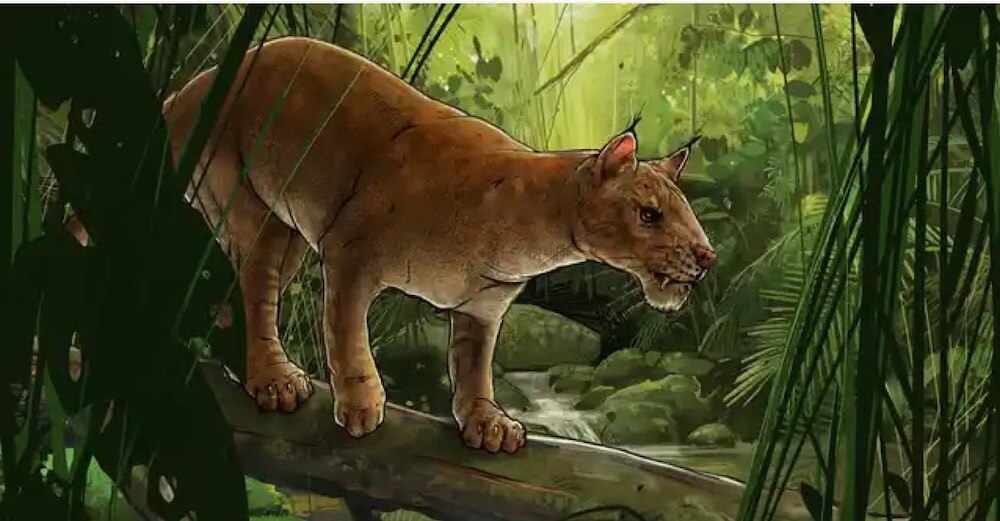Create a free profile to get unlimited access to exclusive videos, sweepstakes, and more!
Flesh-eating, saber-tooth terror was one of the first hypercarnivorous mammals
It's the teeth. Definitely the teeth.

Even someone who has put up with with a cat from hell would rather deal with hisses and hairballs than a thing with knives for teeth and a craving for flesh.
Diegoaelurus vanvalkenburghae was not just a saber-tooth cat. It was also one of the first hypercarnivorous mammals, meaning meat was the only thing it ate (if its teeth are any indication). Its 42-million-year-old fossilized jawbone was just another specimen languishing away in a museum drawer until paleontologists Shawn Zack, Ashley Poust and Hugh Weaver of the University of Arizona and the San Diego Natural History Museum realized it belonged to an entirely new species. They coauthored a study recently published in Peerj. Poust realized that the jawbone belonged to a saber-toothed monster because its teeth gave that away.
“We know from the slicing teeth that this animal was a committed meat-eater and couldn't have survived without hunting," she told SYFY WIRE. "It had serrations on the lower teeth, something that matches the serrations on the big fangs and occurs in saber-toothed animals, and also a huge bony flange, an extension of the chin to protect the saber teeth when the jaw was closed."
Though it must have appeared feline, Diegoaelurus was not an actual cat. It was a machaeroidine (machero- literally means knifelike). Their teeth stand out when compared to those of cats, which evolved later, even though there is some overlap. It is thought to be one of the earliest mammals to have been so dependent on meat that it would not have survived unless it hunted. Now extinct, machaeroidines were the oldest mammals that had evolved saber teeth, highly effective for taking a bite out of thick-skinned ungulates, predecessors of rhinos, tapirs and horses that were around during the Eocene era. It might have even gone for some primates.
What Diegoaelurus did have in common with existing felines is hypercarnivory. Some of the things you feed your cat might not be entirely made of meat, but in the absence of cat food and leftovers from last night’s dinner, felidae are carnivores through and through. Just ask a tiger or a leopard.
The jawbone of this terror (bottom left) had been hiding in plain sight, but looking at its serrated teeth leaves no doubt it was ferocious. Instead of molars and premolars, it had carnassials in the back, bladelike and made to slice right through unsuspecting prey. At the end of a stretch of empty space are the unmistakable canine saber teething the front. The flange on the chin of Diegoaelurus not only protected its killer fangs but accommodated the deep roots of its bottom teeth, and that chin structure also gave it a boost in strength so it could exert more bite force on its prey.
Even without a complete skull (like that of the Smilodon next to it in the photo above, which is the poster child of saber-toothed mammals), the teeth on that jaw that identified it as a machaeroidine were enough to figure out it would have had much larger saber teeth towards the front of its upper jaw. Imagine the jaws of Diegoaelurus being a smaller, but no less monstrous, version of Smilodon’s. Its chin is also more pronounced, perhaps to help the smaller predator get a grip on something writhing between its teeth. Smilodon would not come around until 2.5 million years ago.
So how did adaptations like this evolve, and if catlike things that flashed saber teeth were apex predators, why did they all eventually go extinct? Having nothing alive to compare them to complicates the search for an answer. It is possible their prey died out by the last Ice Age. That still doesn't explain why much earlier forms like Diegoaelurus vanished.
"It's hard to fully understand the pressures that lead to either the evolution or the extinction of sabertooth animals, because we still aren't exactly sure how they were using these adaptations in their hunting, or even if they were all using them the same way," said Poust.
Having nothing alive to compare the Diegoaelurus fossil to reveals the first evidence that different lineages of machaeroidines existed. Phylogenetic analysis revealed that it was definitely one of these fearsome creatures, since it was related to Apataelurus, which lived around the same time.
Machaeroidines would not be prowling through North America for long after Diegoaelurus was around. It is the latest known species, and after it vanished, it would have been replaced by other extinct saber-tooth mammals known as nimravids.
Something else the discovery of Diegoaelurus has done for paleontology in more of the temporal gap between the disappearance of North American machaeroidines and the emergence of nimravids. There still is a gap there, possibly because there have not been many fossils found from that time in between, but that doesn’t necessarily mean the machaeroidines had vanished yet. It is possible competition with nimravids wiped them out.
Will saber teeth ever evolve again? Machaeroidines and nimravids were saber-toothed pseudo-cats, and carnivorous marsupials knows as thylacosmilids also flashed some serious fang, but the saber tooth disappeared with Smilodon. Even lions struggle with large prey and could use an adaptation like that.
No mammals alive now have saber teeth, though they might be making a comeback in clouded leopards.This species may not be a machaeroidine, but it has some features that are argued to be similar.
"Who knows what the future will bring?" Poust said. "If we create a world where big cats like the clouded leopard aren't driven to extinction then maybe, someday, we could have saber-tooth animals once more."



























